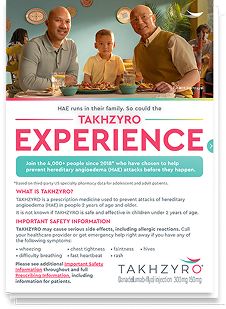When HAE runs in the family, TAKHZYRO may be an option

TAKHZYRO is the first and only preventive treatment indicated for children with HAE 2 years of age and older. This means it could be a preventive option for you and your family members with HAE.
When multiple members of the family are on TAKHZYRO, you can all navigate your treatment journey together.
Navigating the journey as a family together
See if TAKHZYRO might be an option for you or your family members.

To report SUSPECTED ADVERSE REACTIONS, contact Dyax Corp., a Takeda company, at 1-877-TAKEDA-7 (1-877-825-3327), or FDA at 1-800-FDA-1088 or www.fda.gov/medwatch.
HAE runs in their family. So could the TAKHZYRO experience.
Learn about the hereditary nature of HAE and talk to your doctor about TAKHZYRO and if it may be an option for you and your loved ones.
Every family has shared genes. The smile gene, the height gene, the curly hair gene, the lack of hair gene, and for some, the HAE gene.
These families also share their choice of TAKHZYRO, the only prescription medication used to prevent HAE attacks in people 2 years of age and older.
In the clinical study, people taking TAKHZYRO had 87% fewer HAE attacks with an average monthly attack rate of 0.3 with TAKHZYRO versus 2 with placebo.
TAKHZYRO may cause serious side effects, including allergic reactions. Call a doctor right away if you experience wheezing, difficulty breathing, chest tightness, fast heartbeat, faintness, rash, or hives. The most common side effects were injection site reactions (such as pain, redness, and bruising), upper respiratory infection, headache, rash, dizziness, diarrhea, and muscle aches.
So if you or a member of your family have HAE, talk to your doctor to see if fewer attacks are possible with TAKHZYRO.
Join the community of people who are managing their HAE attacks with TAKHZYRO.


